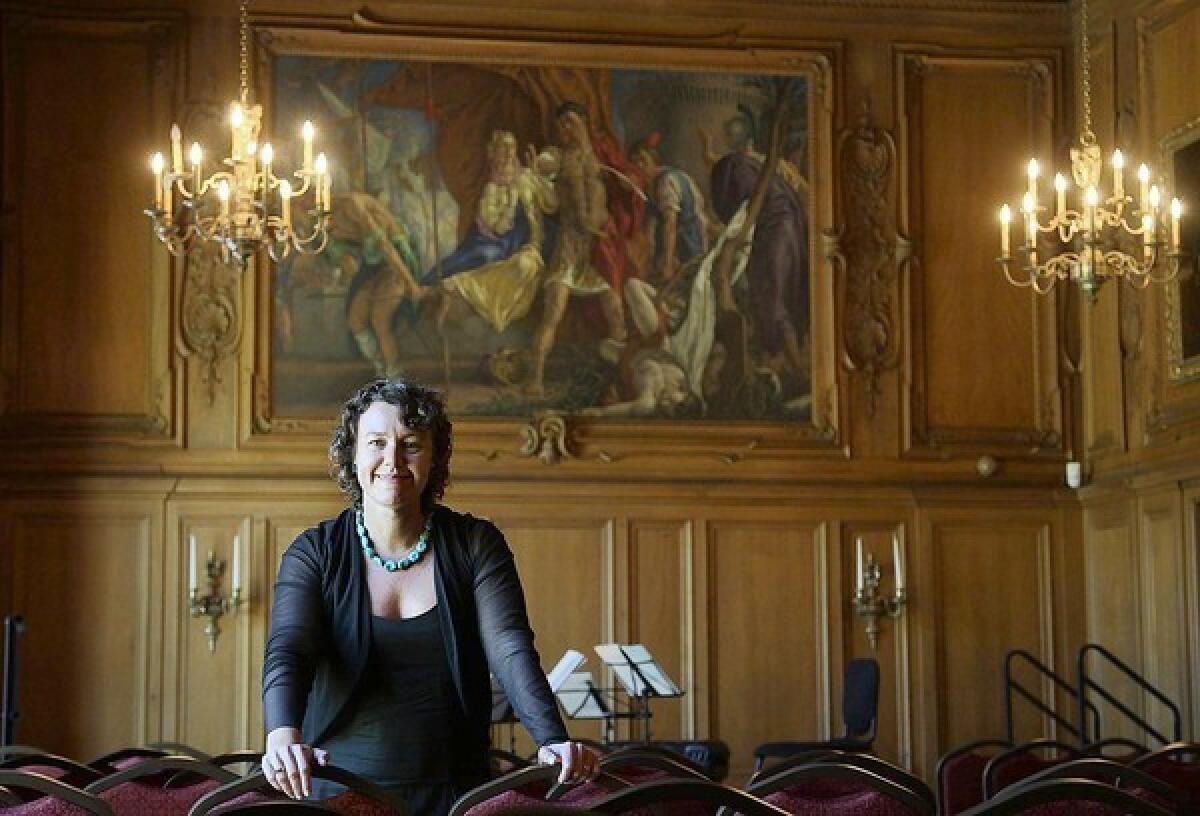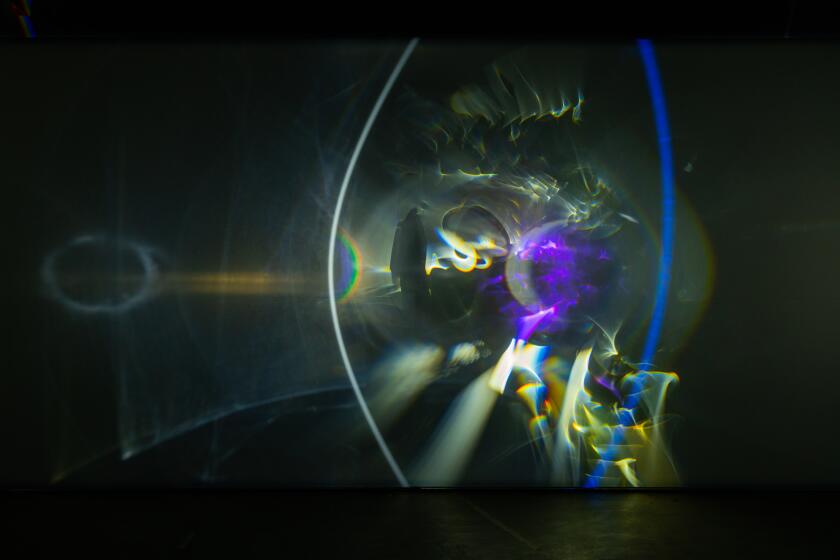Giving chamber music a spotlight in an intimate setting

It was a balmy late-autumn Sunday in L.A.’s historic West Adams district, during what Henry James would’ve called “the perfect middle” of the afternoon.
Nattily dressed visitors strolled through a hedge-rowed Italianate garden bathed in ocher light. Some paused to admire the facade of a handsome Baroque red-brick building, inspired by Sir Christopher Wren’s Hampton Court in London.
Yet the prime attraction was taking place inside, not outside, UCLA’s William Andrews Clark Memorial Library. About 100 people had come to listen to the American String Quartet perform a challenging program of Bach, Beethoven and Bartók, in a wood-paneled drawing room so acoustically rich and deftly proportioned that audience members could not only hear the musicians perfectly but almost touch them.
PHOTOS: Arts and culture in pictures by The Times
“The connection is really palpable,” said Barbara Fuchs, a UCLA professor and director of the UCLA Center for 17th- and 18th-Century Studies, which for 19 years has organized concerts for Chamber Music at the Clark. Sometimes, she added, the musicians “stop and talk to the audience, because they can do it in this intimate setting. It’s very immediate.”
Chamber music in Greater Los Angeles takes place in venues as scattered and diverse as the city itself. In small concert halls and private mansions; in museum courtyards, seaside churches and hidden gardens.
But perhaps no local chamber music series has a more distinctive site-specific profile than Chamber Music at the Clark, which hosts six to nine concerts per season and will close out this season with an April 21 concert by Pacifica Quartet. The ensemble, based in Bloomington, Ind., will perform the first four of the 15 string quartets into which Dmitri Shostakovich poured the intensely personal feelings that he couldn’t vent in his semi-official role as musical interpreter of the Stalinist party line.
For classical aficionados, of course, music is the main draw of any chamber series. The Clark’s specialty has been spotting young, up-and-coming musicians as well as lesser-known established talent, and developing long-term relationships that will lead to repeat engagements. The Talich Quartet, a highly regarded Czech chamber ensemble that has evolved through various personnel lineups since the 1960s, and the 28-year-old German violin virtuoso Augustin Hadelich, are among the artists who’ve performed several times at the Clark.
“There’s that sense of the excitement of discovering them early on in their careers or discovering groups that have not had a lot of exposure in the U.S.,” Fuchs said. “When we, sadly, can’t afford them anymore it’s because they have gone on to greater things.” (Hadelich, for example, is performing this summer at the Hollywood Bowl.)
Yet what also sets the Clark apart is its setting, the Clark Library, a building that might look more at home in Tuscany or along the Thames than in an L.A. residential enclave bounded by the 10 Freeway. Constructed in 1926, the library was bequeathed to UCLA by William Andrews Clark Jr. A copper-mining scion, devout Anglophile and amateur musician, Clark is best remembered for founding and, for a time, single-handedly financing the Los Angeles Philharmonic. (His portrait hangs opposite the drawing-room doorway.)
UCLA now owns and operates the property, including modern administrative offices and a reception hall, with the help of a $1.5-million bequest. The stone-and-brick library houses one of the country’s largest rare-book manuscript and print collections, with an emphasis on 17th- to 19th century British literature. Its Oscar Wilde holdings draw visiting scholars from all over the world.
FULL COVERAGE: 2013 Spring arts preview
But its centerpiece is the drawing room. Adapted by architect Robert Farquhar from the design of the Sala del Collegio of the Doge’s Palace in Venice, Italy, it’s lined with carved English oak and ceiling murals of scenes drawn from John Dryden’s play “All for Love,” based on the story of Antony and Cleopatra. Lectures, scholarly talks and a poetry program as well as concerts are held there, activities that Fuchs hopes to expand in coming years. Plays pertaining to the Clark’s scholarly focus also have been staged in the drawing room, including a recent production of William Wycherley’s Restoration comedy “The Country Wife.”
Music programs are chosen by a small committee that includes Fuchs’ predecessor, Peter Reill, who founded the chamber music series and established its reputation. Bruce Whiteman, a musicologist, poet and former head librarian, still writes the erudite concert program notes, which some patrons keep and study for years.
“We’re very fortunate that Peter is helping us out, because I’m definitely a friend of chamber music, but it’s not my metier,” said Fuchs, a comparative literature scholar who wrote her doctoral thesis on how the rivalry between Tudor England and Imperial Spain affected literary production in those countries during the age of Shakespeare and Cervantes.
The Clark’s intimate setting evokes chamber music’s origins as a gathering of small numbers of professional or amateur musicians to perform in the friendly confines of each other’s homes rather than in concert halls. Chad Smith, vice president of artistic planning for the Los Angeles Philharmonic, says that series like the Clark’s and the highly respected 40-year-old Da Camera Society of Mount St. Mary’s College, which holds concerts in historic L.A. private homes and buildings, are “putting the ‘chamber’ back in chamber music.”
“It’s about the room,” Smith said. “They find those spaces, and they often program for those spaces really cleverly.”
Alas, the Clark library building (including two underground annexes), the gardens, a gatehouse and the walls enfolding them are all that remains of Clark’s original 4.73-acre estate. The rest was demolished decades ago as the neighborhood around it was slipping into decline.
But what’s left exemplifies the architectural richness of the West Adams district, which has rebounded in recent years thanks to a wave of home-owner restorationists and a strong neighborhood association.
“It’s such an excellent sound, like the inside of a piano. The music just vibrates in that room,” said John Kurtz, who has lived in West Adams for 25 years and has been attending Clark concerts since their inception.
Still, the Clark’s location, 13 miles from UCLA’s main campus in Westwood, remains a challenge. Fuchs has instituted free shuttle transport from UCLA for those attending seminars at the Clark, but at this point “there isn’t really a critical mass of people” that would justify operating the shuttle for concert dates.
By necessity rather than choice, the Clark is one of the region’s most exclusive chamber concert series. Because demand consistently exceeds the roughly 100-seat supply, tickets are awarded by a lottery system.
A top priority for Fuchs is building on the tradition of chamber concerts to increase the Center’s cultural outreach efforts to the community, including local school children. She also wants to grow the number of students from UCLA and other colleges attending concerts. Part of that strategy was to implement a $10 student ticket price starting in 2011.
In coming years, Fuchs also hopes to sponsor a guest-artist residency. And fundraising and planning efforts are underway to restore the gatehouse and convert it into a learning and multipurpose space.
In the growing ecosystem of SoCal chamber music presenters, the Clark wants visitors to feel welcome whenever they drop in on the estate.
“It’s wonderful that audiences have these kinds of choices,” Fuchs said of L.A.’s chamber music scene. “I also think that the more varied the profile, the more likely it is that we’re going to be able to engage new audiences, which for me is really key.”
MORE
INTERACTIVE: Christopher Hawthorne’s On the Boulevards
Depictions of violence in theater and more
PHOTOS: Arts and culture in pictures
More to Read
The biggest entertainment stories
Get our big stories about Hollywood, film, television, music, arts, culture and more right in your inbox as soon as they publish.
You may occasionally receive promotional content from the Los Angeles Times.











